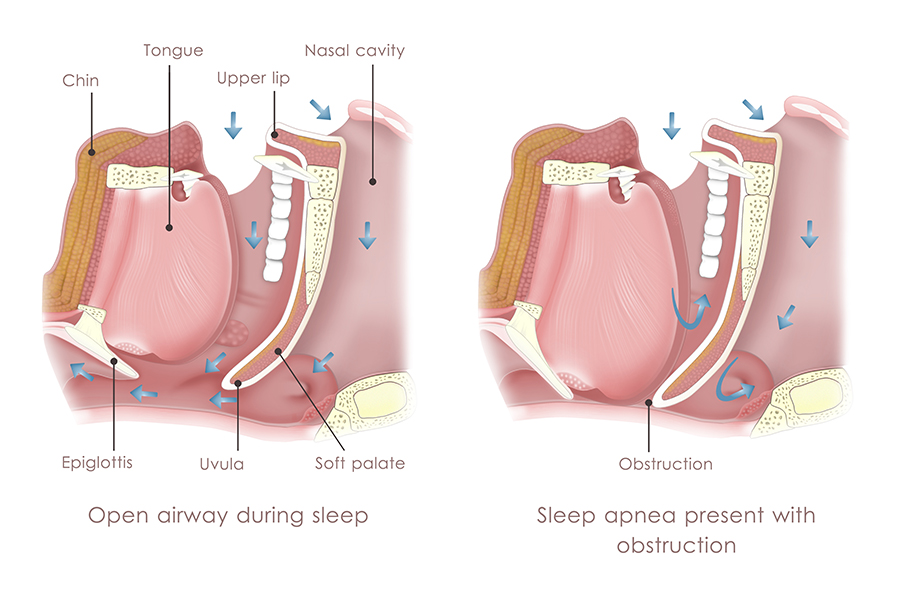Sleep Apnea & Snoring

Obstructive sleep apnea and snoring have gained recent level of awareness among most people. We are just recently become aware of the effect of a good night’s sleep on our daytime activities and productivity.
Snoring
Refers to the audible sound that is generated during sleep. Certain individuals with a pattern of blockage may snore part or most of the night. Diagnosis of snoring is readily made by anybody witnessing your sleep. Often this causes embarrassing social situations as well as marital friction.
Obstructive Sleep Apnea
Refers to actual blockage of breathing that happens in the middle of your sleep. In short, a typical person needs to spend 1.5 to 2 hours of uninterrupted sleep in REM phase of sleep. This is also the paralyzed phase where we dream. However, if due to obstructive reasons the patient stops breathing from brief moments to seconds, this phase of sleep is frequently interrupted. Therefore, even if you invest 8 hours of sleep time, your sleep quality may not be adequate to compensate for your daily activities.
Ongoing sleep apnea issues can lead to fatigue, sleepiness, lack of generalized energy, overeating, obesity, high blood pressure, heart attacks, and strokes. A prompt diagnosis of obstructive sleep apnea can lead to more timely treatment protocol tailored to each individual’s needs.

The diagnosis of sleep apnea is usually made by a sleep test (presence or absence of sleep apnea cannot be accurately predicted based on your bed partner’s observations). This is a noninvasive technique where parameters are measured during one or more nights of sleep, and calculations are made based on the severity of the symptoms. The traditional setting is that of a sleep laboratory where you sleep overnight. Alternatively, home sleep tests are also available. Although you have the convenience of sleeping in your own bed at night, the results may not be as accurate as a laboratory testing.
Treatments
The treatment of obstructive sleep apnea and/or snoring usually has three basic components.
Weight reduction
For those patients who are considered to be overweight or obese, weight reduction has been shown to be the most effective way in reducing your symptoms. In order to determine your own level of obesity, please use the following formulation for body mass index (BMI calculation), and compare your number to the normal values on the right.
| BMI= | (weight in pounds) x 703 | |
| (height in inches)2 | ||
Normal weight = 18.5-24.9
Overweight = 25-29.9
Obesity = BMI of 30 or greater
Devices
The most commonly used device in treatment of sleep apnea includes CPAP therapy. The basic principle includes application of positive air pressure into the nasal passages, so that your breathing passages remain open throughout the night. This is a very safe and effective treatment, which does not involve surgery and the healing phase. Another treatment includes nasal strips applied to the back of the nose. This would be effective if the major point of blockage is at the level of the nostrils only. Another modality is bite-blocks that would keep your tongue displaced forward. This aims to keep your throat open during your sleep. Once again, this is only effective if tongue enlargement is the major cause of blockage. Many of these devices and others have been shown to be very effective in the treatment of your symptoms. The major drawback of all of them is that they have to be used indefinitely for proper maintenance of your relief.
Surgery
Surgical intervention usually tries to address the points of blockage. In regarding to the snoring, the most commonly performed procedure is reduction of the uvula (“little tongue”). This could be achieved by laser procedure versus implants like pillar device. In treating sleep apnea, more involved surgery may be necessary to open up the nasal passages (septoplasty, turbinate reduction) as well as throat (tonsillectomy, uvulopalatopharyngoplasty). Read more about Surgery for Obstructive Sleep Apena ››
After initial evaluation by Dr. Namdar, most patients typically undergo overnight sleep test to study the degree of their blockage. According to the results, an individual treatment plan is tailored for each patient. If you have previously undergone another sleep test prior to your first visit, kindly bring these results with you for evaluation.
Read our blog for further discussion of the decision-making process for treatment of sleep apnea.

